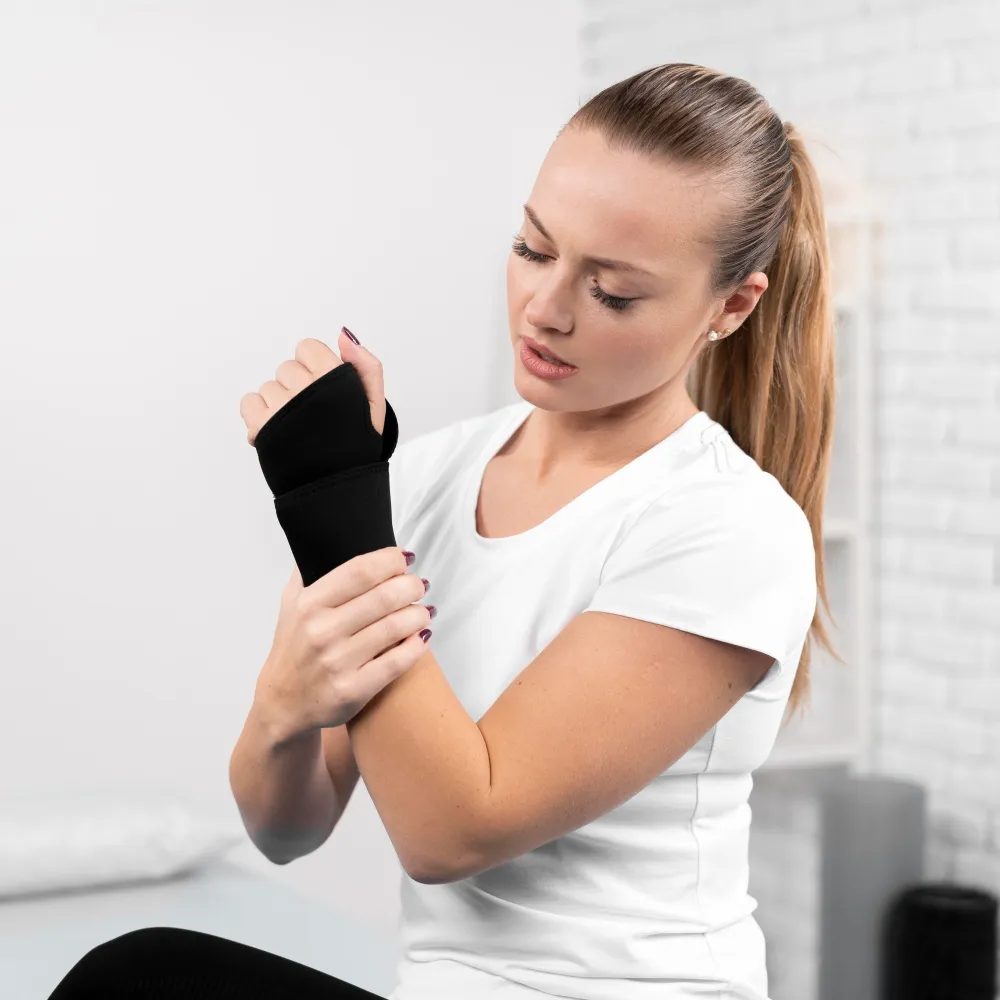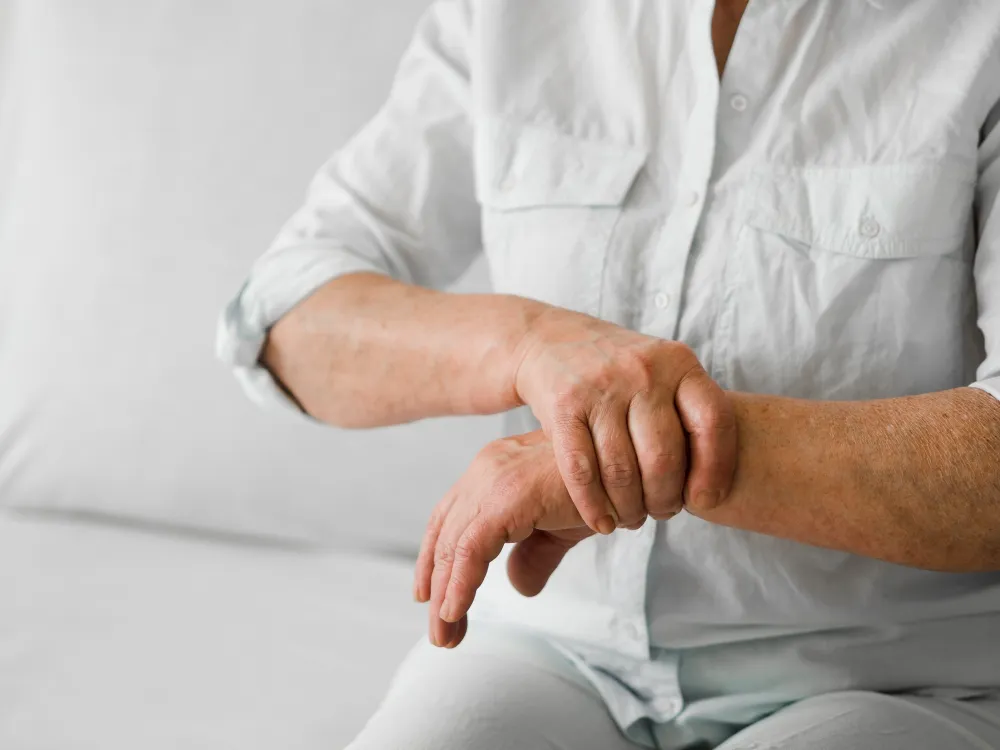Wrist instability
Understanding SLAC-Wrist and its effects
Scapholunate advanced collapse arthropathy (SLAC-Wrist) is a progressive degenerative disease of the wrist. It develops due to chronic instability between the scaphoid and lunate bones, often following an untreated or improperly treated ligament injury. Over time, this instability leads to osteoarthritis, joint wear and tear and a considerable loss of function.
Patients with SLAC-Wrist often suffer from pain, limited mobility and problems with everyday activities that require strength and flexibility in the wrist. The disease progression usually follows a predictable pattern: initially, the scapholunate ligament is overstretched or torn, resulting in abnormal movement. As the disease progresses, osteoarthritis develops in the radiocarpal and metacarpophalangeal joints, further limiting function and increasing discomfort. Without proper treatment, degeneration can significantly impair quality of life and make even simple movements, such as grasping objects or typing on a keyboard, painful and difficult.

Causes and symptoms of SLAC-Wrist
The main cause of SLAC-Wrist is a chronic injury to the scapholunate ligament that disrupts the normal biomechanics of the wrist. This ligament is crucial for the stability of the wrist. If it is damaged, there is excessive movement between the scaphoid and lunate bones, which in the long term leads to cartilage wear and eventually to osteoarthritis.
Typical symptoms of SLAC-Wrist
- Persistent pain, especially on the radial side of the wrist
- Weakness and reduced grip strength
- Swelling of the wrist
- Stiffness and limited range of motion
- A noticeable crunching or rubbing in the joint due to cartilage loss
Treatment options for SLAC-Wrist
Conservative therapy
In the early stages of the disease, conservative measures can help to alleviate symptoms and delay surgery. These treatments include
- Wrist orthoses to stabilize the joint
- Non-steroidal anti-inflammatory drugs (NSAIDs) to reduce pain and inflammation
- Corticosteroid injections for temporary pain relief
- Physiotherapy to strengthen the surrounding muscles and support the weakened ligament
However, these measures do not treat the underlying cause of the condition and often only provide temporary relief. If the disease progresses, surgical treatment is required to restore function and relieve pain.

Surgical treatment options
Depending on the severity of the disease and the functional needs of the patient, various surgical procedures are available. The two main categories are arthrodesis (joint fusion) and reconstructive surgery.
Arthrodesis (joint fusion)
Arthrodesis is a definitive procedure in which the affected bones are fused together to eliminate all movement in the joint. This procedure is usually recommended for patients with advanced osteoarthritis who have severe pain and significant functional limitations.
Advantages of arthrodesis
- Effective pain relief by eliminating movement in the damaged joint
- High stability and long-term durability
- Lower risk of renewed instability or further degenerative damage
Disadvantages of arthrodesis
- Complete loss of movement in the stiffened area
- Adaptation required through increased movement compensation via elbow and shoulder
Reconstructive procedures
For patients who wish to retain a certain degree of mobility, joint-preserving reconstructive procedures can be an alternative to fusion.
Proximal row carpectomy (PRC)
In this procedure, the first three carpal bones (scaphoid, lunate and triquetrum) are removed in order to reduce pain and maintain mobility.
Advantages
- Maintaining a certain degree of mobility
- Good pain relief for moderate to advanced SLAC-Wrist
- Faster rehabilitation compared to complete arthrodesis
Disadvantages
- Less hand strength than after arthrodesis
- Risk of further joint degeneration over time

Partial arthrodesis (limited wrist fusion)
Only certain joint areas are stabilized, while others retain a certain degree of mobility.
Advantages
- Combination of stability and mobility
- Less stressful than a complete stiffening
- Better functionality in everyday life than after a complete arthrodesis
Disadvantages
- Residual pain possible
- Requires longer rehabilitation time than PRC
Wrist prosthesis (arthroplasty)
In some cases, a wrist prosthesis may be an option. This involves replacing damaged joint surfaces with an artificial implant to maintain mobility and reduce pain.
Advantages
- Maintaining wrist mobility
- Good pain reduction
Disadvantages
- Less durable than an arthrodesis
- Less suitable for younger or very active patients
Comparison between arthrodesis and reconstructive procedures
The choice between arthrodesis and reconstructive surgery depends on several factors:
- Severity of osteoarthritis - Arthrodesis is often the better choice for severe osteoarthritis.
- Patient's lifestyle - patients who need more mobility are more likely to benefit from reconstructive procedures.
- Pain intensity and functional demands - arthrodesis offers the best pain relief, while reconstructive procedures provide a balance between pain reduction and function.
Success rates and patient outcomes
Studies show that both arthrodesis and reconstructive procedures can significantly improve symptoms.
- Arthrodesis: High success rate for pain relief and stability, but with complete loss of motion.
- Proximal row carpectomy and partial arthrodesis: Good pain relief while maintaining some mobility, especially in less advanced osteoarthritis.
Frequently asked questions
SLAC-Wrist is a degenerative disease of the wrist caused by chronic instability between the scaphoid and lunate bones.
Early signs are pain, weakness and reduced grip strength. Stiffness and restricted movement occur over time.
Treatment ranges from conservative measures such as physiotherapy and medication to surgical interventions such as arthrodesis or reconstructive procedures.
For patients with severe osteoarthritis, arthrodesis can provide a permanent solution to pain, but at the expense of mobility.
Contact and further information
Please contact me for further information or a consultation at my practice in Vienna.